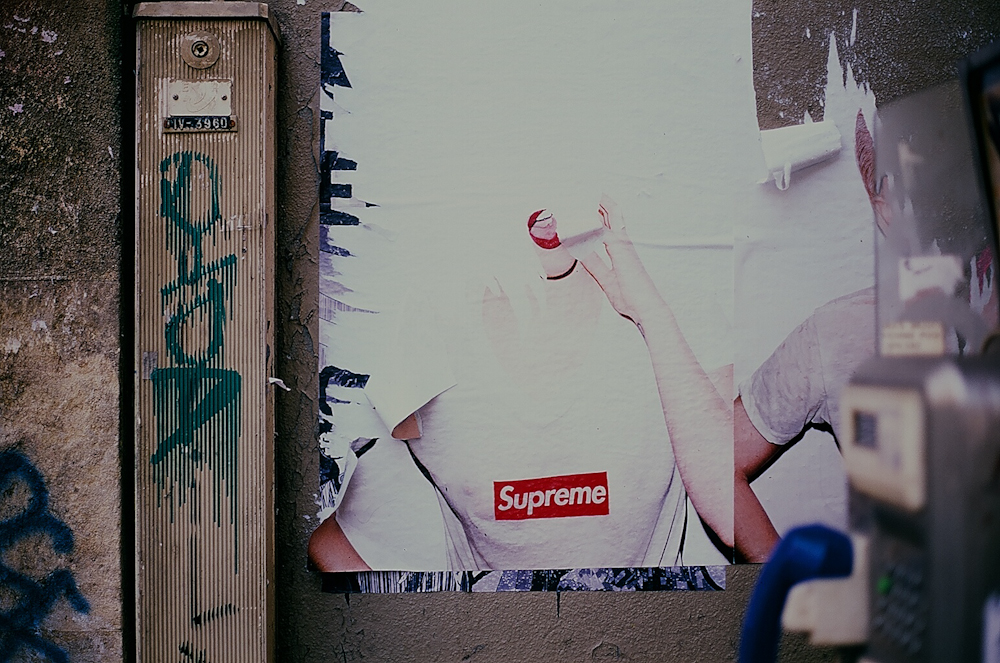A red box logo with white, bold lettering characterizes the ever so iconic Supreme brand. Established in April 1994 as skatewear, Supreme has evolved into one of the world’s most popular and in-demand streetwear fashion labels, valued at one billion dollars. The impact that Supreme is leaving on the fashion industry as well as the way companies think of the traditional supply and demand model is impressive.
Supreme has built hype around its brand with its innovative business model. The company artificially maintains scarcity of its products by creating two collections spanning two seasons every year. Every Thursday acts as a “drop day” during which a limited number of products from that season’s collection are released, in the meager quantity of five to seven of any particular sweater or hoodie.
The “drop” is a sales tactic employed by several streetwear brands to “supercharge the traditional supply-and-demand model”. Information is usually slowly leaked via one small announcement, and then amplified on social media through celebrities, collectors, and influencers. Some die-hard fans go as far to pay an e-commerce company to deploy web bots to connect to the Supreme server at the moment of the drop. To be able to “shop the drop” at one of Supreme’s eleven stores, customers must get on a list weeks in advance and wait in long lines.
Once products are released online, they sell out in a matter of seconds, before quickly appearing on resale websites often marked up ten times the initial price. A few high-end fashion houses such as Gucci and Moncler have begun to adopt this strategy. These houses will make certain designs and colors a rarity, making each article of article of clothing much more valuable not only in monetary value, but in terms of street cred.
Moreover, this scarcity model has opened up a thriving secondary market. Those who resell can make upwards of $200,000 every year in revenue. Such entrepreneurs find their customers through online marketplaces such as GOAT, Grailed, or StockX.
StockX is particularly innovative. It describes itself as the “stock market of things.” The website operates with the same principles of the stock market, bringing buyers and sellers together into one platform. The website’s team works to authenticate each product, thereby regulating the market and maintaining the reputation and exclusivity of individual brands and products.
This secondary market has revolutionized the way fans of brands like Supreme approach the fashion industry. Since pieces increase in value over time, therefore increasing the longevity of items, consumers are willing to invest time and money to build their collections. In today’s fast-fashion dominated industry, this is quite rare.
Supreme’s billion dollar valuation comes after the company sold a 50 percent stake in its business to the Carlyle Group for a reported $500 million. As of September 2018, only 168 companies in the United States had reached billion-dollar valuations. However, many investors wonder how, with only 11 stores that are open once a week and an online shop, Supreme takes in enough revenue to justify being valued as a one billion dollar brand. Supreme does not mark up its products on its website. Investors such as the Carlyle Group are betting that Supreme will increase future production, but that would sacrifice it’s reputation as a hyper-exclusive and niche brand.
Over the past 25 years, Supreme’s founder, James Jebbia, has placed a focus on slow growth, so that the brand can maintain its reputation in the “underground, in-the-know streetwear fashion scene.” The brand doesn’t pay for traditional advertising; instead, it relies on word-of-mouth and the reputation that it has built, transforming the act of purchasing a Supreme product into a micro-experience. Collaborations with other brands and designers such as Louis Vuitton and Comme de Garçons as well as the release of novelty accessories such as bricks, dog bowls, and hair clippers have also bolstered the popularity of Supreme and its distinguishment as a brand that challenges boundaries in the fashion world.
Supreme has refused to compromise, and has maintained an authenticity throughout the years. As said by Jebbie himself, “We’re making stuff we’re proud of…not doing stuff to stay alive. I don’t think enough people take risks, and when you do, people respond – in music, in art, in fashion.“ Thus far, Supreme’s billion dollar valuation has not led to any sacrifices from the brand. Jebbia has been vigilant in keeping the brand close to its roots – a skatewear brand inspired by the skaters of Lafayette Street in New York City’s lower Manhattan.
When Supreme was founded, skate culture was immensely popular. Released around the same time, the movies “Kids” and “Clueless” both depicted different, yet “equally stylized” skate crews. ESPN had just held the first X Games (an annual extreme sports event), placing skateboarding on the map as a mass-market spectacle. Supreme grew out of this culture and has catered to this fanbase ever since.
The brand itself holds a rich history of a scene that has largely contributed to pop culture, and its success can largely be attributed to its business model. Over the years, Supreme will prove to be a case study for how important scarcity is to a brand’s desirability. Next time you see a piece from Supreme, just remember, that it carries a rare legacy of art, sport, and fashion.
Photo: Image via Magdalena O! (Flickr)
